How to edit AVCHD file

By Olga Krovyakova - modified March 4, 2024, created March, 27 2019
Do you actively shoot HD video with your cutting-edge cameras? New format – AVCHD is getting more and more popular. It is already supported by wide range of cameras like Panasonic GH1, Panasonic HDC-SD800, JVC GZ-HM30BEU HD, Sony HDR-CX115EB Full HD, Sony HDR-CX250EB Full-HD, Sony NEX-7B Systemkamera, Canon LEGRIA HF S21 AVCHD-Camcorder and so on and so forth. To meet a need of editing your AVCHD video fast and losslessly – SolveigMM Video Spliter is a best solution ever.
Understanding of some basic terms used in this guide will help you to start using SolveigMM Video Splitter in most comfortable way.
 |
Marker is set to a current cursor position. |
|
|
The selected marker is highlighted with yellow color. |
Markers can be added or deleted. Such operations as deleting and positioning are applied to the selected markers only.
Fragment is a part of video (or audio) file limited by two markers to be removed or kept in a final movie, e.g. commercial block you want to cut off. The fragments can be selected with the slider. Fragments marked as 'cut off' are colored with brown-red color.
Examples of fragments are provided in table below:
| Color of Fragment | Description |
|---|---|
 |
This fragment was set to be deleted. It will not be presented in final movie |
 |
This fragment was set to be kept. It will be presented in final movie |
 |
This fragment was set to be deleted. It will not be presented in final movie. Yellow slider on it means you can edit it (delete, set it to be kept, etc.) |
 |
This fragment was set to be kept. It will be presented in final movie. Yellow slider on it means you can edit it (delete, set it to be cut off, etc.) |
Control Panel contains main tools for file processing.

| Window Element | Description | Shortcut Key |
|---|---|---|
|
|
Button "Add Marker": Adds a new marker to current slider cursor position. |
M
|
|
|
Button "Remove Marker(s)": Removes a current marker or fragment. |
Delete
|
|
|
Button "Invert": Inverts time line fragments. |
I
|
|
|
Button "Set audio silence": Sets the audio silence for the selected fragment. | |
|
|
Button "Save": Starts trimming or Batch Processing (if batch queue has any task). |
Ctrl+T
|
|
|
Edit box of a left marker cursor time position. You can edit this value by manually. | |
|
|
Edit box of a right marker cursor time position. You can edit this value by manually. | |
|
|
Button "Zoom In/Out": Increases/descreases a slider timeline resolution for more comfortable editing neighbor markers (*). |
Num+ Num- |
|
|
Button "Browse output file(s)": opens folder in the File Explorer with the output file. | |
|
|
Audio off/on: turns off/on sound of the whole video track Story board or audio wave off/on: turns off/on the story board or audio wave
|
|
|
(*) - To view timeline areas after Zoom In you can use a scroll bar (below a timeline slider) and "Alt + Left arrow" and "Alt + Right Arrow" hot keys. |
||
1. Click the button or select the Open Media File... command in the File menu.
2. Select file to be edited.
3. Click the button to open the selected file.
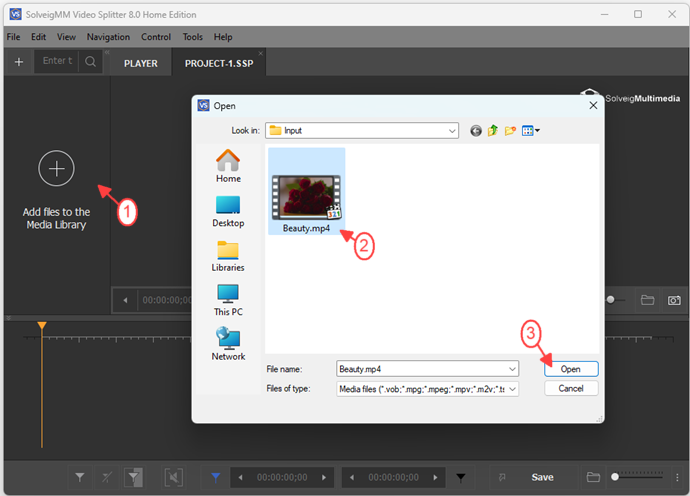
Figure 1
4. Move the file from the Media library to the timeline.
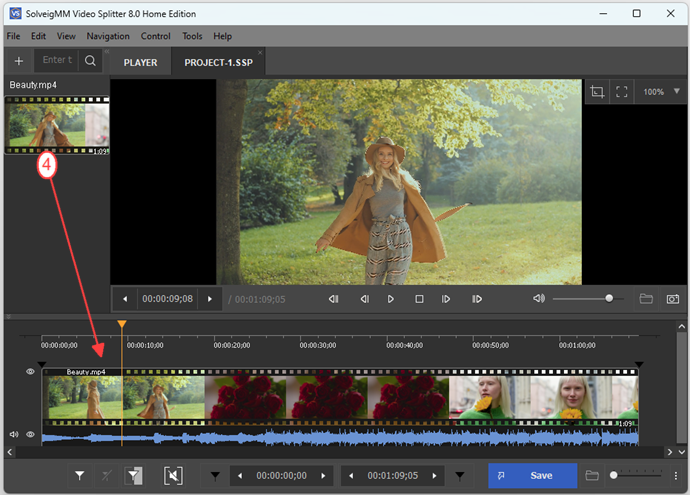
Figure 2
5. Find the beginning of the first part of your movie using Video slider.
6. Click the Add marker button. You can also add the marker by selecting the Add Marker command of the contextual menu or using the [M] key. Then add the marker at the end of the fragment. Markers divide the movie into several fragments (see Basic Terms). In our example we divide our movie into four fragments by adding markers in the required places.
Note: You can cancel the latest action you made. The Undo command of the Edit menu is intended for cancelling the last action. The command name also contains the name of the last action, e.g. Undo (Add Marker), see Figure 3. The Redo command of the Edit menu is used to perform the cancelled action. This command is inactive if no actions were undone. When the command is undimmed it contains the name of the last undone action (see Figure 3).
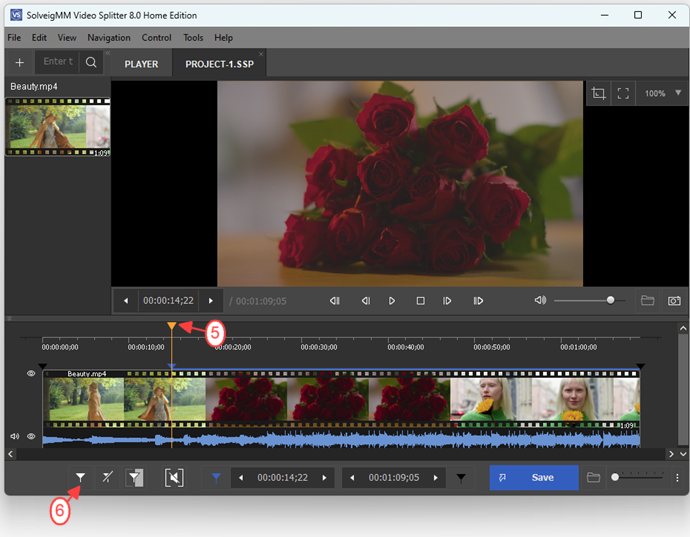
Figure 3
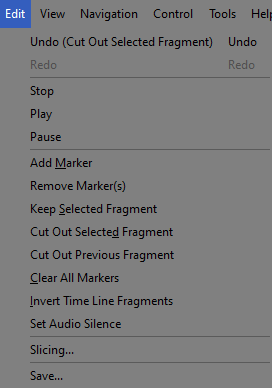
Figure 4
7. Select the fragment you want to cut out of from the movie by moving your mouse cursor to the area between the markers of such fragment.
8. Click the "scissors" button to mark the selected fragment as 'cut off'. The fragment's color will be changed to brown-red. (see Basic Terms).

Figure 5
8. Select other fragments you want to cut out of from the movie. In our example we marked the second fragment as 'cut off' as described in 7.
9. Click the "Save" button to start the file processing.
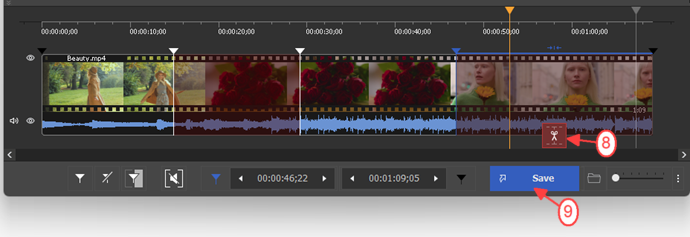
Figure 6
10. Enter new file name in the appeared Save As window.
11. Click the Save button. You will see the current progress of the splitting process.
The new saved file will not contain the two fragments marked as 'cut off'.
Additional information about features of SolveigMM Video Splitter can be found on the website and in the SolveigMM Video Splitter User Guide.
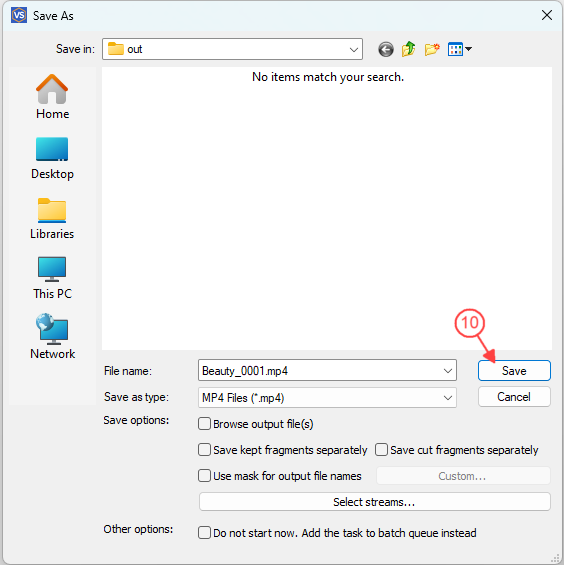
Figure 7
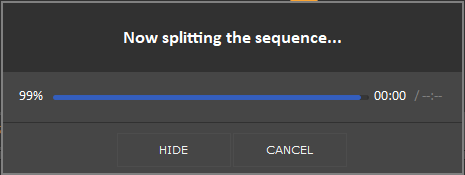
Figure 8
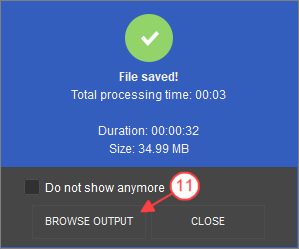
Figure 9
- https://www.solveigmm.com/en/howto/how-to-edit-mpeg2-file-with-video-splitter/
- https://www.solveigmm.com/en/howto/how-to-join-avchd-files-with-solveigmm-video-splitter/
 Olga Krovyakova is the Technical Support Manager in Solveig Multimedia since 2010.
Olga Krovyakova is the Technical Support Manager in Solveig Multimedia since 2010.
She is the author of many text and video guidelines of company's products: Video Splitter, HyperCam, WMP Trimmer Plugin, AVI Trimmer+ and TriMP4.
She works with programs every day and therefore knows very well how they work. Сontact Olga via support@solveigmm.com if you have any questions. She will gladly assist you!
 Eng
Eng  Rus
Rus  Deu
Deu  Ital
Ital  Esp
Esp  Port
Port  Jap
Jap  Chin
Chin